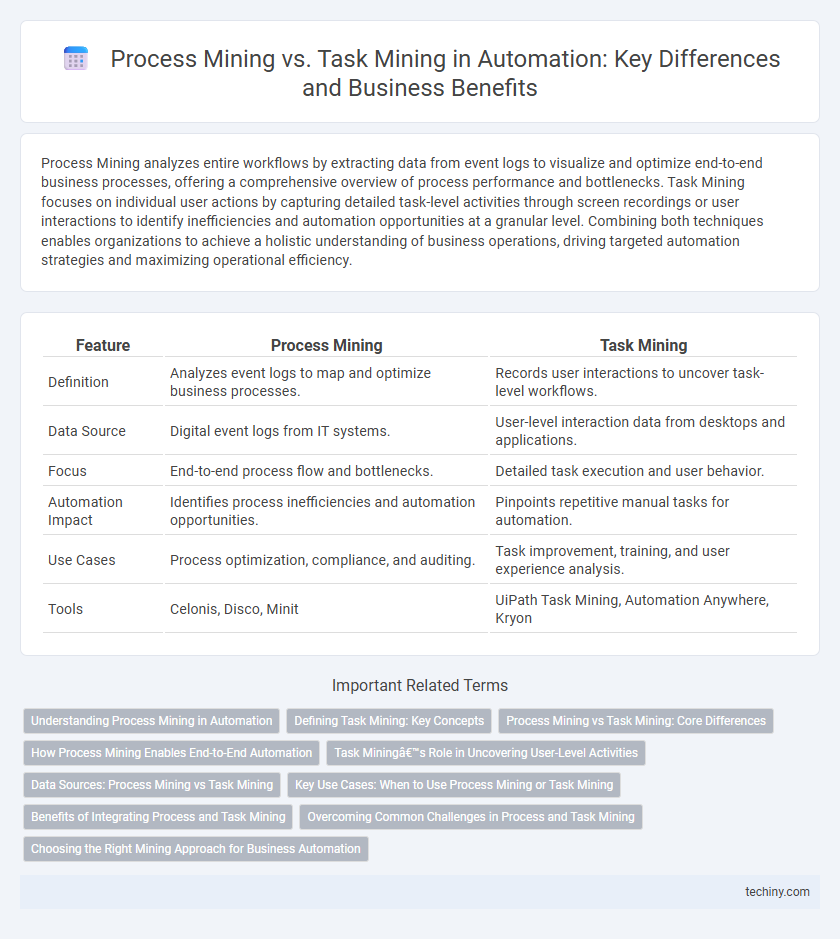Process Mining analyzes entire workflows by extracting data from event logs to visualize and optimize end-to-end business processes, offering a comprehensive overview of process performance and bottlenecks. Task Mining focuses on individual user actions by capturing detailed task-level activities through screen recordings or user interactions to identify inefficiencies and automation opportunities at a granular level. Combining both techniques enables organizations to achieve a holistic understanding of business operations, driving targeted automation strategies and maximizing operational efficiency.
Table of Comparison
| Feature | Process Mining | Task Mining |
|---|---|---|
| Definition | Analyzes event logs to map and optimize business processes. | Records user interactions to uncover task-level workflows. |
| Data Source | Digital event logs from IT systems. | User-level interaction data from desktops and applications. |
| Focus | End-to-end process flow and bottlenecks. | Detailed task execution and user behavior. |
| Automation Impact | Identifies process inefficiencies and automation opportunities. | Pinpoints repetitive manual tasks for automation. |
| Use Cases | Process optimization, compliance, and auditing. | Task improvement, training, and user experience analysis. |
| Tools | Celonis, Disco, Minit | UiPath Task Mining, Automation Anywhere, Kryon |
Understanding Process Mining in Automation
Process Mining in automation analyzes event logs from IT systems to visualize and optimize end-to-end business processes, identifying bottlenecks and inefficiencies. It provides data-driven insights by reconstructing actual workflows, enabling organizations to enhance process transparency and compliance. Leveraging Process Mining leads to improved operational performance and informed decision-making in automated environments.
Defining Task Mining: Key Concepts
Task mining involves capturing and analyzing user interactions with software applications to uncover detailed task-level activities and patterns. It focuses on the granular execution of individual tasks by utilizing data from user interfaces, such as mouse clicks, keystrokes, and screen recordings, to provide insights into task efficiency and bottlenecks. This approach complements process mining by drilling down to the micro-level actions that contribute to overall process performance and automation opportunities.
Process Mining vs Task Mining: Core Differences
Process Mining analyzes event logs from IT systems to visualize and optimize entire workflows, identifying bottlenecks and inefficiencies at the process level. Task Mining captures user interactions and activities on desktops to understand granular task execution and uncover hidden work patterns. The core difference lies in Process Mining's focus on end-to-end process structures using system data, whereas Task Mining emphasizes detailed task-level insights through user behavior analysis.
How Process Mining Enables End-to-End Automation
Process mining analyzes event logs from IT systems to visualize and optimize entire workflows, enabling organizations to identify bottlenecks and inefficiencies across end-to-end processes. Unlike task mining, which focuses on individual user interactions at the desktop level, process mining provides a comprehensive, data-driven map of operational processes, facilitating scalable automation initiatives. By uncovering the full process landscape, process mining supports continuous improvement and drives implementation of automated workflows that span multiple systems and departments.
Task Mining’s Role in Uncovering User-Level Activities
Task Mining plays a crucial role in uncovering user-level activities by capturing detailed interactions such as mouse clicks, keyboard inputs, and application usage patterns. Unlike Process Mining, which analyzes event logs to map overall workflows, Task Mining provides granular insights into individual user behavior, enabling organizations to identify inefficiencies and optimize repetitive tasks. Leveraging advanced AI-driven analytics, Task Mining enhances automation strategies by revealing hidden task variations and user-specific bottlenecks.
Data Sources: Process Mining vs Task Mining
Process Mining analyzes event logs from IT systems such as ERP, CRM, and BPM platforms to visualize end-to-end process flows and uncover bottlenecks. Task Mining captures user interactions at the desktop level through screen recordings, user activity tracking, and application usage data for granular task-level insights. Combining event log data with user interaction data enhances automation opportunities by providing a comprehensive view of both process execution and individual task performance.
Key Use Cases: When to Use Process Mining or Task Mining
Process mining is best suited for analyzing end-to-end business processes by extracting data from event logs to identify bottlenecks, inefficiencies, and compliance issues across complex workflows. Task mining focuses on capturing user interactions at the desktop level to uncover repetitive manual tasks, enabling targeted automation and user experience improvements. Organizations leverage process mining for high-level process optimization and regulatory compliance, while task mining drives detailed task automation and workforce productivity enhancement.
Benefits of Integrating Process and Task Mining
Integrating process mining and task mining provides a comprehensive view of business operations by combining macro-level process flow analysis with micro-level task execution details, enabling organizations to identify inefficiencies and bottlenecks more accurately. This integration enhances automation strategies by uncovering hidden process variations and employee behavior patterns, leading to more targeted and effective robotic process automation (RPA) deployments. Companies leveraging both technologies can achieve improved process transparency, faster issue resolution, and higher operational efficiency, ultimately driving cost reduction and customer satisfaction.
Overcoming Common Challenges in Process and Task Mining
Process Mining excels in mapping end-to-end workflows by analyzing event logs, while Task Mining captures detailed user interactions, providing granular insights for automation optimization. Overcoming common challenges involves integrating both techniques to address incomplete data and variability in processes, ensuring comprehensive visibility and accurate root cause analysis. Leveraging AI-driven analytics enhances anomaly detection and process conformance, boosting the effectiveness of automation initiatives.
Choosing the Right Mining Approach for Business Automation
Process mining analyzes end-to-end workflows by extracting data from event logs to identify bottlenecks and inefficiencies, making it ideal for optimizing overall business processes. Task mining captures detailed user interactions with applications to uncover repetitive manual tasks suitable for automation, providing granular insights for task-level improvements. Selecting the right mining approach depends on whether the automation goal targets broad process optimization or specific task enhancement within business automation strategies.
Process Mining vs Task Mining Infographic

 techiny.com
techiny.com